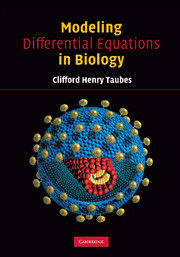Book contents
- Frontmatter
- Contents
- Preface
- Chapter 1 Introduction
- Chapter 2 Exponential Growth
- Chapter 3 Introduction to Differential Equations
- Chapter 4 Stability in a One-Component System
- Chapter 5 Systems of First-Order Differential Equations
- Chapter 6 Phase Plane Analysis
- Chapter 7 Introduction to Vectors
- Chapter 8 Equilibrium in Two-Component, Linear Systems
- Chapter 9 Stability in Nonlinear Systems
- Chapter 10 Nonlinear Stability Revisited
- Chapter 11 Matrix Notation
- Chapter 12 Remarks About Australian Predators
- Chapter 13 Introduction to Advection
- Chapter 14 Diffusion Equations
- Chapter 15 Two Key Properties of the Advection and Diffusion Equations
- Chapter 16 The No-Trawling Zone
- Chapter 17 Separation of Variables
- Chapter 18 The Diffusion Equation and Pattern Formation
- Chapter 19 Stability Criterion
- Chapter 20 Summary of Advection/Diffusion
- Chapter 21 Traveling Waves
- Chapter 22 Traveling Wave Velocities
- Chapter 23 Periodic Solutions
- Chapter 24 Fast and Slow
- Chapter 25 Estimating Elapsed Time
- Chapter 26 Switches
- Chapter 27 Testing for Periodicity
- Chapter 28 Causes of Chaos
- Extra Exercises and Solutions
- Index
Chapter 1 - Introduction
Published online by Cambridge University Press: 05 June 2012
- Frontmatter
- Contents
- Preface
- Chapter 1 Introduction
- Chapter 2 Exponential Growth
- Chapter 3 Introduction to Differential Equations
- Chapter 4 Stability in a One-Component System
- Chapter 5 Systems of First-Order Differential Equations
- Chapter 6 Phase Plane Analysis
- Chapter 7 Introduction to Vectors
- Chapter 8 Equilibrium in Two-Component, Linear Systems
- Chapter 9 Stability in Nonlinear Systems
- Chapter 10 Nonlinear Stability Revisited
- Chapter 11 Matrix Notation
- Chapter 12 Remarks About Australian Predators
- Chapter 13 Introduction to Advection
- Chapter 14 Diffusion Equations
- Chapter 15 Two Key Properties of the Advection and Diffusion Equations
- Chapter 16 The No-Trawling Zone
- Chapter 17 Separation of Variables
- Chapter 18 The Diffusion Equation and Pattern Formation
- Chapter 19 Stability Criterion
- Chapter 20 Summary of Advection/Diffusion
- Chapter 21 Traveling Waves
- Chapter 22 Traveling Wave Velocities
- Chapter 23 Periodic Solutions
- Chapter 24 Fast and Slow
- Chapter 25 Estimating Elapsed Time
- Chapter 26 Switches
- Chapter 27 Testing for Periodicity
- Chapter 28 Causes of Chaos
- Extra Exercises and Solutions
- Index
Summary
This chapter and the subsequent 27 chapters are about differential equations and how they are applied by biologists. As the branch of mathematics called differential equations is a direct application of ideas from calculus, and as this is a mathematics text, I should begin by telling you a little bit about what is meant by the term differential equation. However, I'll digress first to begin an argument for including mathematics in the tool kit of a working biologist.
Modeling in the Biological Sciences
First, I freely admit to not being a biologist. In fact, until I started teaching the course on which this book was based, I knew very little of recent work in biology. I took biology in high school, dissected a worm and a frog, and happily found other interests. Subsequently, I kept minimally abreast of the subject by reading articles from popular science journals such as Science News and Scientific American. However, since I started teaching this course, I have endeavored to educate myself about modern biology and have found it to be a glorious thing. In fact, I would be happy to argue the case that our understanding of biology now ranks as the (or at least one of the) crowning achievements of human knowledge.
My recent and ongoing education in biology has taught me the following lesson: With some notable exceptions, biology at the cusp of the twenty-first century is very much an experimentally driven science. Life is extremely complicated, and sorting out these complications is the task at hand.
Information
- Type
- Chapter
- Information
- Modeling Differential Equations in Biology , pp. 1 - 5Publisher: Cambridge University PressPrint publication year: 2008
